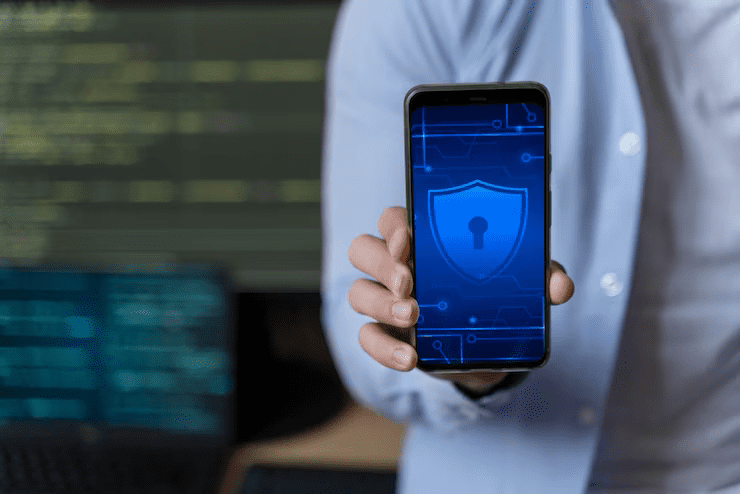In today’s digital age, mobile app development has become a critical aspect of businesses worldwide. As the demand for mobile apps continues to grow, so does the need for robust security measures to protect users and their data. The number of mobile cyberattacks in December 2021 alone was registered to be 228,801 and is a reminder of how susceptible mobile apps can be to online threats.
App development companies must prioritize mobile app security to safeguard their applications from threats and vulnerabilities. In this article, we touch upon the need for mobile app security and discuss some best practices that development companies can follow to ensure their users’ highest level of mobile app security.
The Need for Mobile App Security
Mobile app security has become an indispensable aspect of the digital ecosystem as our reliance on mobile applications grows. In a world where sensitive data, such as personal and financial information, is constantly exchanged, ensuring the security of mobile apps is vital. This protects users from unauthorized access, data breaches, and identity theft and preserves their privacy. In addition, robust security measures help build user trust, maintain brand reputation, and comply with regulatory requirements like GDPR and HIPAA. Strong security measures shield businesses from potential service disruptions and revenue loss due to cyberattacks, ensuring a smooth user experience and fostering the app’s overall success.
As you read further, we elaborate upon 11 best practices for protecting users and data as you launch your next mobile app.
1. Secure Code Development
The foundation of any secure mobile app lies in its code. Mobile App development companies should implement safe coding practices from the beginning of the development process. This includes adhering to industry-standard guidelines like the OWASP Mobile Security Project and regularly reviewing and updating code to mitigate potential vulnerabilities. By integrating security testing and code review throughout the development cycle, mobile app developers can identify and address security issues early on, reducing the risk of exploitation.
2. Data Encryption
Encrypting sensitive data is a crucial aspect of mobile app security. App development companies should ensure that all data transmitted between the app and backend servers is encrypted using industry-standard encryption protocols such as HTTPS, SSL, or TLS. Additionally, data stored on the device should be encrypted using strong encryption algorithms to protect it from unauthorized access, even if the device is lost or stolen.
3. Strong Authentication and Authorization Mechanisms
Implementing robust authentication and authorization mechanisms is essential for verifying user identity and controlling access to sensitive data and functionalities. Mobile app developers should consider implementing multi-factor authentication (MFA), which combines multiple methods of verification (e.g., passwords, biometrics, or one-time codes) to enhance security. Furthermore, it is suggested that we follow the principle of least privilege to ensure that users are granted the minimum level of access necessary to perform their tasks.
4. Secure Data Storage and Transmission
App development companies must ensure their mobile apps store and transmit data securely to prevent unauthorized access and data leakage. This involves implementing secure storage solutions, such as using built-in platform features like iOS’s Keychain or Android’s Keystore System. Additionally, mobile app developers should follow best practices for handling sensitive data, such as tokenizing or anonymizing it when possible and ensuring secure communication channels with backend servers.
5. Regular Security Testing
To maintain a high level of mobile app security, development companies should conduct regular security testing throughout the app’s lifecycle. This includes performing vulnerability assessments, penetration testing, and code reviews to identify potential security risks and vulnerabilities. By integrating security testing into the mobile app development process, developers can quickly address any issues and ensure the app’s security remains current.
6. Implementing App Security Frameworks and Libraries
Leveraging existing security frameworks and libraries can help mobile app developers to implement security best practices more efficiently. These tools provide pre-built, tested solutions for common security concerns, such as encryption, authentication, and secure communication. Using reputable and well-maintained security frameworks allows app development companies to save time and effort while ensuring their mobile app security is robust and current.
7. Regular Updates and Patches
Regularly updating and patching mobile apps is essential for maintaining security, as new threats and vulnerabilities are continually emerging. App development companies should monitor for security updates and patches for their apps, as well as any third-party libraries or frameworks they are using. By promptly addressing known vulnerabilities and applying patches, developers can significantly reduce the risk of security breaches and protect their users’ data.
8. User Education and Awareness
App developers should pay attention to the role of user education and awareness in mobile app security. By providing users with clear, easy-to-understand information about the app’s security features and best practices for protecting their data, developers can help users make informed decisions about their security and privacy. This may include creating in-app guides, FAQs, or tutorials that explain how users can enable security features, set strong passwords, and recognize potential security threats.
9. Implementing Secure APIs
APIs are essential to mobile app development, enabling apps to communicate with backend servers and other services. App development companies should ensure their APIs are secure and adhere to industry best practices. This includes implementing proper authentication and authorization mechanisms, validating and sanitizing input data, and employing rate limiting to prevent abuse.
10. Monitoring and Logging
Continuous monitoring and logging of app activity can help developers detect and respond to security incidents more quickly. App development companies can gain valuable insights into user behavior, system performance, and potential security threats by implementing a comprehensive monitoring and logging strategy. This information can be used to identify vulnerabilities, investigate incidents, and improve the app’s overall security posture.
11. Protecting Against Reverse Engineering and Tampering
Mobile apps are vulnerable to reverse engineering and tampering, exposing sensitive data and intellectual property or allowing attackers to modify the app’s behavior. App developers should employ code obfuscation and runtime integrity checks to protect their apps from reverse engineering and tampering. Additionally, developers can use app shielding or app hardening solutions to enhance further the app’s security and resilience against these threats.
Conclusion
As mobile applications continue to permeate every facet of our lives, the need to protect sensitive data and preserve user privacy becomes more pronounced. By prioritizing mobile app security, developers and businesses can foster user trust, enhance brand reputation, and meet regulatory requirements.
The collaborative effort between developers, businesses, and users is crucial in creating a safe environment for mobile app usage. Security measures are not only the responsibility of developers and businesses but also involve user awareness. Educating users about the risks associated with unsecured apps, sharing best practices for securing their devices, and encouraging strong passwords can contribute to a more secure mobile ecosystem. To conclude, mobile app security is not a one-time effort but an ongoing process that requires diligence, foresight, and adaptability. In a world where digital transformation is accelerating, mobile app security will continue to be a critical factor in determining the success and longevity of mobile applications. By prioritizing security, businesses can deliver a seamless and safe user experience, foster long-lasting customer relationships, and maintain a strong market presence. Our collective responsibility is to ensure a safe and secure mobile ecosystem for all.


